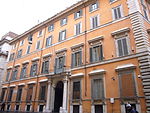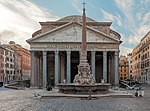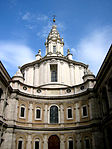Baths of Nero

The Baths of Nero (Thermae Neronis) or Baths of Alexander (Thermae Alexandrinae) were a complex of ancient Roman baths on the Campus Martius in Rome, built by Nero in either 62 or 64 and rebuilt by Alexander Severus in 227 or 229. It stood between the Pantheon and the Stadium of Domitian and were listed among the most notable buildings in the city by Roman authors and became a much-frequented venue. These thermae were the second large public baths built in Rome, after the Baths of Agrippa, and it was probably the first "imperial-type" complex of baths, with a monumental scale and symmetrical, axially-planned design. While in the sixteenth century the foundations of the caldarium were still visible, nothing else of the structure remains above ground except some fragments of walls incorporated into the structure of Palazzo Madama.
Excerpt from the Wikipedia article Baths of Nero (License: CC BY-SA 3.0, Authors, Images).Baths of Nero
Piazza di Sant'Eustachio, Rome Municipio Roma I
Geographical coordinates (GPS) Address Nearby Places Show on map
Geographical coordinates (GPS)
| Latitude | Longitude |
|---|---|
| N 41.8987 ° | E 12.4758 ° |
Address
Sant’Eustachio in Campo Marzio (Basilica di Sant'Eustachio)
Piazza di Sant'Eustachio
00186 Rome, Municipio Roma I
Lazio, Italy
Open on Google Maps








